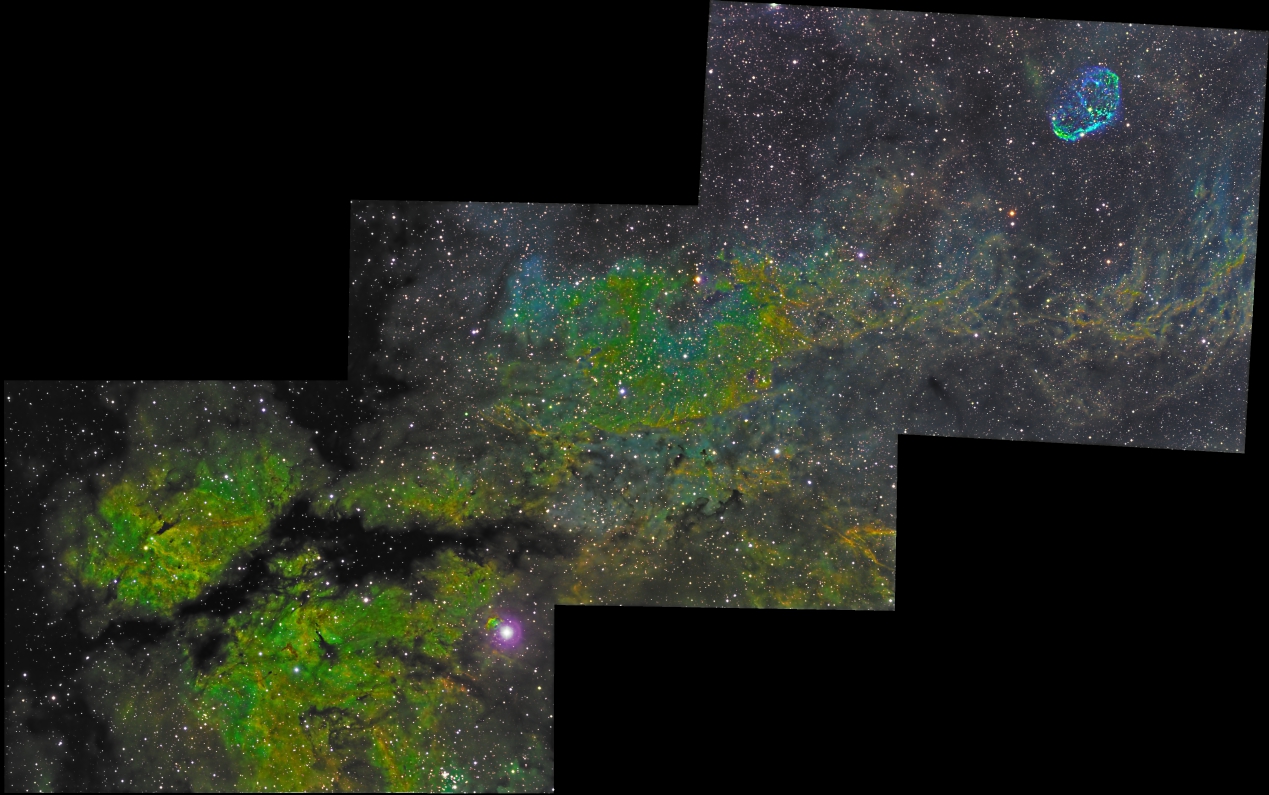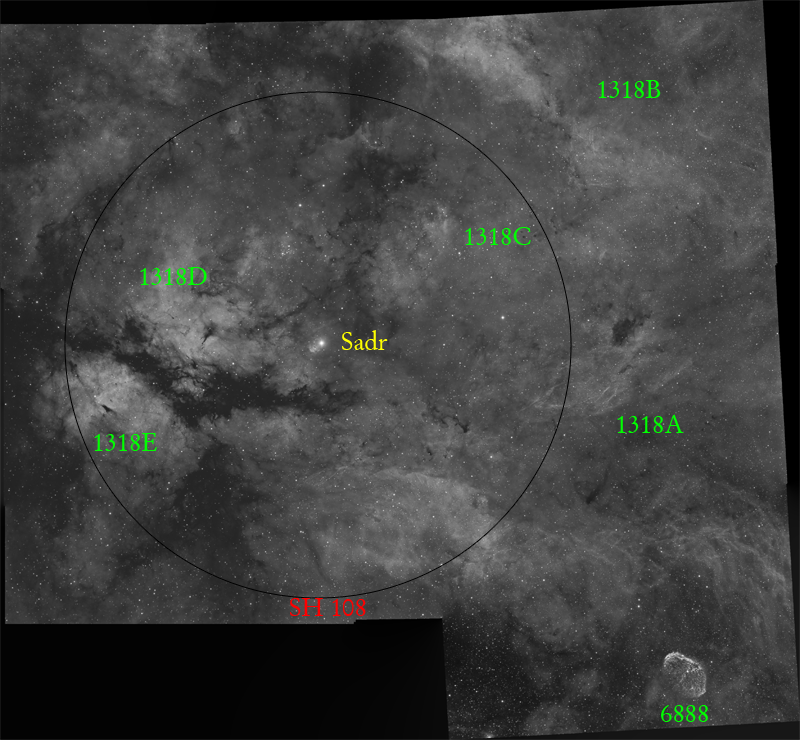SH108 Sadr area of Cygnus
May
- October 2012
Remastered Nov 2105
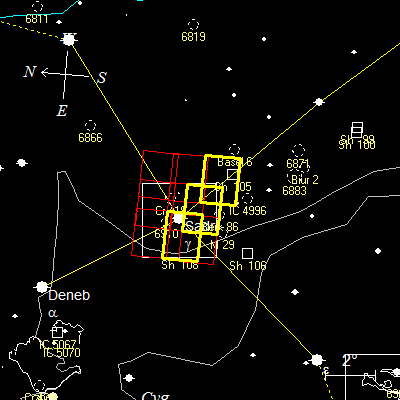
click for a larger map
|
My project for the summer of 2012 was the SH108 area
around the bright star Sadr in the constellation Cygnus. Cygnus is
well positioned at my location and some DSS images of the area
looked interesting. Last year I imaged the nearby Crescent
Nebula. Originally I started with just the area around Sadr,
but then expanded to include a 6 tile mosaic covering the entire
area cataloged as Sharpless 108.
Steve Gottlieb discussed this same area in the September 2012 issue
of Sky and Telescope. His article made me aware of some problems
with the cataloging of the area. The multi part IC 1318 is most of
SH 108. What I learned from Steve's article and subsequent emails
with him is that the exact labeling of the parts of IC1318 is not
locked down. The labeling published by the NGC/IC project and the
annotation file supplied with PixInsight differs from the labeling
used in Uranometria.
Since Steve used Uranometria I modified
the Pixinsight annotation to agree with Steve's article.
The second problem is that Uranometria labels SH108 as one of the
clouds to the SW of Sadr. According to the original
paper by Sharpless, SH108 is a 180 arcminute area centered
roughly on Sadr. SkyMap Pro (left) shows this as a square of that
size which is correct. Pixinsight uses a 180 arcminute circle which
is its form of notation. Uranometria should make clear that SH108
includes almost all of IC 1318.
After seeing the Sky and Telescope article I expanded my original
plan of a 6 tiled mosaic into a 9 tile mosaic. That allowed me to
capture the parts of IC 1318 that are not included in SH 108 which
matched the picture in Sky and Telescope. I also added a tile to
the SW to capture the clouds around the Crescent and place them in
context with the rest of the Sadr nebulosity.
|
Since this project required a huge amount of data the full mosaic is only H
alpha. I also captured Sulfur and Oxygen data on the central portion
(marked in Yellow).
SH108 in H- alpha
Color Slice
Sometimes when you are not satisfied with something it just grates on you.
That was the case with the 2012 color version. While the feathery nebula
near NGC 6888 looked good, the rest of the nebula was burned out with little
detail. Applying the learning from the 2014 Katonah Pixinsight workshop I
went back and reprocessed the original data. The version displayed below
shows much more detail in SH 108. While the feathery stuff is less
prominent, I believe the overall effect is a plus.
Hydrogen dominates the clouds around Sadr. Using the Katonah reprocessing
I greatly increased the amount of Sulfur and Oxygen displayed. I also
tuned the processing to reveal the subtle structure in SH108.
click for a scrollable image
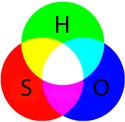
|
"Hat" on Crescent Nebula
As I was processing the images of my original Crescent project last fall
I discovered that there is a "hat" of Oxygen visible in the image.
After several attempts I could not get it to show this time. Its weak
signal was buried in the stronger H signal. Here is the "hat" using just
Oxygen.
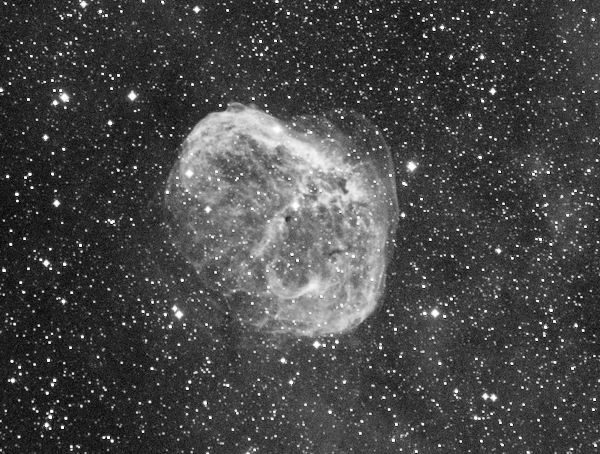
Annotated Images
As mentioned above the exact catalog designations for bright areas of IC
1318 is not nailed down. Here are the annotations using the designations
in Uranometria
|
click for an annotated scrollable image
|
Processing Details
This project required a truly massive amount of data. I started data
collection in May right before sunrise and concluded it in October before
my eclipse trip. The H alpha image consists of 9 mosaic frames. The
central color slice is 3 frames
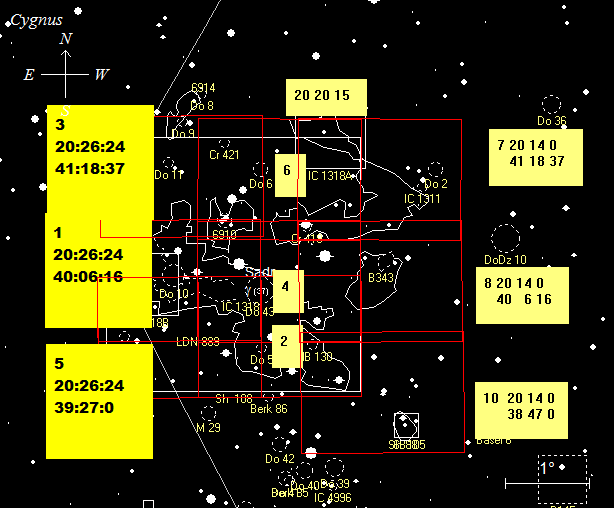
click for full size
For the first time I did this entire project bin 2. I don't fully
remember why I did this, but the result was that instead of oversampling
seeing problems and then eliminating them in Pixi they became a part of
the final image. While bin 2 is more sensitive, I could have captured the
same information bin 1. Thus on my next project I returned to using bin
1.
Tile
|
Filter
|
Exposure
|
M1
|
H
|
45x900
|
|
O
|
45x900
|
|
S
|
50x900
|
|
|
|
M2
|
H
|
41x900
|
|
O
|
30x900
|
|
S
|
41x900
|
|
|
|
M3
|
H
|
50x900
|
M4
|
H
|
47x900
|
M5
|
H
|
53x900
|
M6
|
H
|
40x900
|
M7
|
H
|
32x900
|
M8
|
H
|
32x900
|
| (Tile 9 was not used) |
|
|
M10
|
H
|
26x900
|
|
O
|
39x900
|
|
S
|
38x900
|
I also collected data using Photometric filters to see if I could get
correct star colors. Since I only committed a couple of nights to this my
data was less than perfect. My conclusion was that the extra effort was
not worthwhile.
For some reason some of my O images had a high pedestal. I do not know
if this was a transparency issue or some problem with calibration. I had
to use PixelMath to subtract the pedestal before GradientMergeMosaic would
correctly process the images.
Copyrights for Photos

